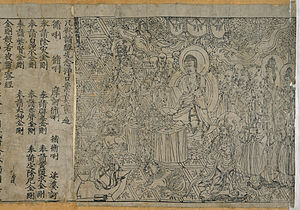| This article includes a list of references, related reading, or external links, but its sources remain unclear because it lacks inline citations. Please help improve this article by introducing more precise citations. (December 2020) (Learn how and when to remove this message) |
Banhua (Chinese: 版画) is the Chinese umbrella term for any printed art objects, and especially for those made by woodblock printing, the term used for woodcuts from Asia.
History
Main article: Woodblock printing


The direct translation of 'Banhua' is 'printed picture', it is a general term for original prints or printmaking as an art form. 'Banhua' is composed of two characters: 'ban' (版) meaning 'block' and 'hua' (画) meaning 'picture'. Banhua's meaning is not limited to prints in Chinese style.
As printing first appeared in 3rd-century China, artists started to use woodblock printing or other methods to spread their works. Buddhist classics, novel illustrations, and the banknote were among the first public works to be printed in China.
From the 17th century, prints of New Year pictures became popular.
See also
References
- "banhua | Definition | Mandarin Chinese Pinyin English Dictionary | Yabla Chinese". chinese.yabla.com. Retrieved 2020-12-08.
- Lufkin, Felicity (2016-01-21). Folk Art and Modern Culture in Republican China. Lexington Books. ISBN 978-1-4985-2629-6.
- HUANG, SHIH-SHAN SUSAN (2011). "MEDIA TRANSFER AND MODULAR CONSTRUCTION: The Printing of Lotus Sutra Frontispieces in Song China". Ars Orientalis. 41: 135–163. ISSN 0571-1371. JSTOR 23075962.